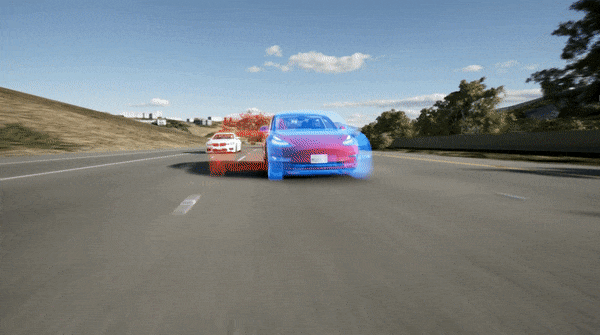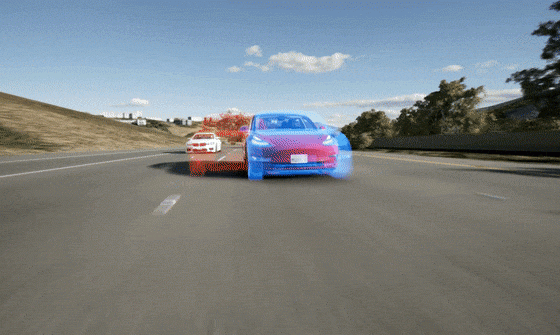Tesla FSD version 10.69.2.3 rolled out shortly after AI Day. The latest update of Tesla’s Full Self Driving software delivers minor bug fixes. Some testers have received v10.69.2.3 and shared their observations with Teslarati.
As previously noted, 10.69.2.3 is a relatively small update that addresses some minor bugs in FSD Beta. As it sometimes goes with software bug fixes, some Beta testers mentioned a new issue in the latest version that appeared to be a step or two backward.
Road Obstacle Detection Issues
A few testers in Tesla’s FSD Beta Program reported experiencing road obstacle detection issues when their vehicles would not register particular objects in their path or directly ahead.
For instance, beta tester Jonathan shared that his vehicle did not recognize or avoid dead animals on the road. Another beta tester experienced similar issues with gates in his community.
“One day coming back from work I decided to see if it can get me close to the proximity of my house. I live in a gated community. The vehicle made the turn into the drive entry of the community which has two swing gates. Vehicle was almost going to go through the closed gates,” FSD Beta user Sean shared with Teslarati. “I had to tap the breaks and override the system to make it stop. It didn’t see the gates as obstacles or road blocks. I have tried this a couple of times during daylight and night time and result is the same.”
After Tesla released v10.69.2.2, a few beta testers observed that their vehicles recognized and avoided construction work sites and similar obstacles on the road.
Left and Right Turns
A couple of beta testers mentioned issues with left and right turns, specifically during intersections. The most prominent issue FSD Tesla drivers raised about turns was their cars’ hesitation during intersections. Testers highlighted that their cars’ hesitation during intersections isn’t really a big issue until they consider the other drivers on the road.
“Hesitates too long at intersections presumably trying to determine if/when it’s safe to proceed. This only matters to me when there are cars behind me. I feel intense pressure to push the car through (and I do). Humans do not have patience to wait on its time-table,” noted Terry, another FSD Beta tester.
FSD Beta user Dr. Rahaman made similar observations. He noted that his Tesla would creep forward after stopping at an intersection on a red light and would take a left or right turn too slowly, sometimes irritating the drivers behind him. Dr. Rahaman specifically observed that his car entered left turn lanes late without a signal. In the past, the Tesla owner has noted that the car’s turn signals sporadically turn off and on at some intersections or turns.
Lane Selection Issues
Tesla FSD v.10.69.2.3 doesn’t appear to address the largest issue multiple testers have pointed out over the past few weeks: lane selection. One beta tester seemed to sum up the sentiments most drivers in the Tesla FSD program have regarding lane selection.
“Lane selection sometimes just plain wrong and dumb. Causes driving task to be harder for itself than it needs to be because it realizes (eventually, usually) it’s in the wrong lane too late and then has to get over which is harder with traffic and unlike a human who can gesture, the car can give no such signals as to its self-made predicament,” the tester commented.
“Also, it sometimes gets into turn lane just late enough that cars behind me assume I’m continuing straight and swoop in behind me and get over immediately causing it to be even harder for my car to get over into that lane now because all slots are occupied and the road is about to end at a light,” he added.
Other Issues
Some other less prominent issues that a few FSD Beta testers have noted are listed below.
1. Lane Positioning – The car hugs the double yellow lines too closely on narrow roads or sticks to the middle of the road when no lines are present.
2. Wide turns – The Tesla car takes wide turns, far from the curb. One tester observed that his car risked hitting the guard rails and other obstacles with its wide turn.
3. Turn Lane Issues – The car still mistakes turn lanes for driving lanes
Some testers still report experiencing phantom braking and jerkiness while taking turns. However, the one observation that seems to stick out among others came from beta tester Neeraj.
“Drives as if everyone is going to follow the rules 100% and is not accommodating or accounting for those who may not be going 100% as they should,” he said about FSD Beta.
FSD Beta still has a ways to go before 100% autonomous version rolls out to the general public. Observations and tests from beta testers help Tesla improve FSD. Elon Musk teased more significant improvements in the next update, 10.69.3. Tesla hopes to release a ‘supervised’ FSD version by the end of the year.
Have you tried out FSD Beta 10.69.2.3 yet? I’d like to hear from you! Contact me at maria@teslarati.com or via Twitter @Writer_01001101.

News
Tesla is seeing a lot of momentum from young Koreans in their 20s-30s: report
From January to November, young buyers purchased over 21,000 Teslas, putting it far ahead of fellow imported rivals like BMW and Mercedes-Benz.

Tesla has captured the hearts of South Korea’s 20s-30s demographic, emerging as the group’s top-selling imported car brand in 2025. From January to November, young buyers purchased over 21,000 Teslas, putting it far ahead of fellow imported rivals like BMW and Mercedes-Benz.
Industry experts cited by The Economist attributed this “Tesla frenzy” to fandom culture, where buyers prioritize the brand over traditional car attributes, similar to snapping up the latest iPhone.
Model Y dominates among young buyers
Data from the Korea Imported Automobile Association showed that Tesla sold 21,757 vehicles to the 20s-30s demographic through November, compared to BMW’s 13,666 and Mercedes-Benz’s 6,983. The Model Y led the list overwhelmingly, with variants like the standard and Long Range models topping purchases for both young men and women.
Young men bought around 16,000 Teslas, mostly Model Y (over 15,000 units), followed by Model 3. Young women followed a similar pattern, favoring Model Y (3,888 units) and Model 3 (1,083 units). The Cybertruck saw minimal sales in this group.
The Model Y’s appeal lies in its family-friendly SUV design, 400-500 km range, quick acceleration, and spacious cargo, which is ideal for commuting and leisure. The Model 3, on the other hand, serves as an accessible entry point with lower pricing, which is valuable considering the country’s EV subsidies.
The Tesla boom
Experts described Tesla’s popularity as “fandom culture,” where young buyers embrace the brand despite criticisms from skeptics. Professor Lee Ho-geun called Tesla a “typical early adopter brand,” comparing purchases to iPhones.
Professor Kim Pil-soo noted that young people view Tesla more as a gadget than a car, and they are likely drawn by marketing, subsidies, and perceived value. They also tend to overlook news of numerous recalls, which are mostly over-the-air software updates, and controversies tied to the company.
Tesla’s position as Korea’s top import for 2025 seems secured. As noted by the publication, Tesla’s December sales figures have not been reported yet, but market analysts have suggested that Tesla has all but secured the top spot among the country’s imported cars this year.
News
Tesla FSD fleet is nearing 7 billion total miles, including 2.5 billion city miles
As can be seen on Tesla’s official FSD webpage, vehicles equipped with the system have now navigated over 6.99 billion miles.

Tesla’s Full Self-Driving (Supervised) fleet is closing in on almost 7 billion total miles driven, as per data posted by the company on its official FSD webpage.
These figures hint at the massive scale of data fueling Tesla’s rapid FSD improvements, which have been quite notable as of late.
FSD mileage milestones
As can be seen on Tesla’s official FSD webpage, vehicles equipped with the system have now navigated over 6.99 billion miles. Tesla owner and avid FSD tester Whole Mars Catalog also shared a screenshot indicating that from the nearly 7 billion miles traveled by the FSD fleet, more than 2.5 billion miles were driven inside cities.
City miles are particularly valuable for complex urban scenarios like unprotected turns, pedestrian interactions, and traffic lights. This is also the difference-maker for FSD, as only complex solutions, such as Waymo’s self-driving taxis, operate similarly on inner-city streets. And even then, incidents such as the San Francisco blackouts have proven challenging for sensor-rich vehicles like Waymos.
Tesla’s data edge
Tesla has a number of advantages in the autonomous vehicle sector, one of which is the size of its fleet and the number of vehicles training FSD on real-world roads. Tesla’s nearly 7 billion FSD miles then allow the company to roll out updates that make its vehicles behave like they are being driven by experienced drivers, even if they are operating on their own.
So notable are Tesla’s improvements to FSD that NVIDIA Director of Robotics Jim Fan, after experiencing FSD v14, noted that the system is the first AI that passes what he described as a “Physical Turing Test.”
“Despite knowing exactly how robot learning works, I still find it magical watching the steering wheel turn by itself. First it feels surreal, next it becomes routine. Then, like the smartphone, taking it away actively hurts. This is how humanity gets rewired and glued to god-like technologies,” Fan wrote in a post on X.
News
Tesla starts showing how FSD will change lives in Europe
Local officials tested the system on narrow country roads and were impressed by FSD’s smooth, human-like driving, with some calling the service a game-changer for everyday life in areas that are far from urban centers.

Tesla has launched Europe’s first public shuttle service using Full Self-Driving (Supervised) in the rural Eifelkreis Bitburg-Prüm region of Germany, demonstrating how the technology can restore independence and mobility for people who struggle with limited transport options.
Local officials tested the system on narrow country roads and were impressed by FSD’s smooth, human-like driving, with some calling the service a game-changer for everyday life in areas that are far from urban centers.
Officials see real impact on rural residents
Arzfeld Mayor Johannes Kuhl and District Administrator Andreas Kruppert personally tested the Tesla shuttle service. This allowed them to see just how well FSD navigated winding lanes and rural roads confidently. Kruppert said, “Autonomous driving sounds like science fiction to many, but we simply see here that it works totally well in rural regions too.” Kuhl, for his part, also noted that FSD “feels like a very experienced driver.”
The pilot complements the area’s “Citizen Bus” program, which provides on-demand rides for elderly residents who can no longer drive themselves. Tesla Europe shared a video of a demonstration of the service, highlighting how FSD gives people their freedom back, even in places where public transport is not as prevalent.
What the Ministry for Economic Affairs and Transport says
Rhineland-Palatinate’s Minister Daniela Schmitt supported the project, praising the collaboration that made this “first of its kind in Europe” possible. As per the ministry, the rural rollout for the service shows FSD’s potential beyond major cities, and it delivers tangible benefits like grocery runs, doctor visits, and social connections for isolated residents.
“Reliable and flexible mobility is especially vital in rural areas. With the launch of a shuttle service using self-driving vehicles (FSD supervised) by Tesla in the Eifelkreis Bitburg-Prüm, an innovative pilot project is now getting underway that complements local community bus services. It is the first project of its kind in Europe.
“The result is a real gain for rural mobility: greater accessibility, more flexibility and tangible benefits for everyday life. A strong signal for innovation, cooperation and future-oriented mobility beyond urban centers,” the ministry wrote in a LinkedIn post.










